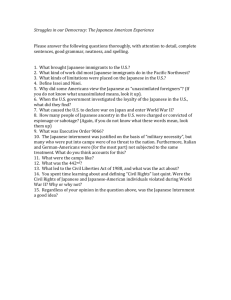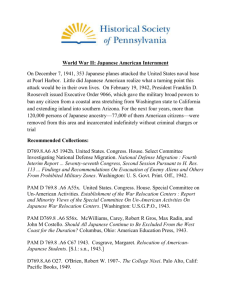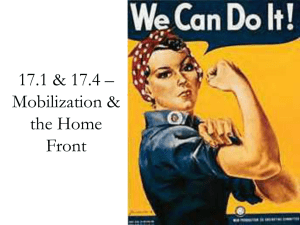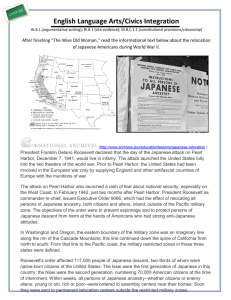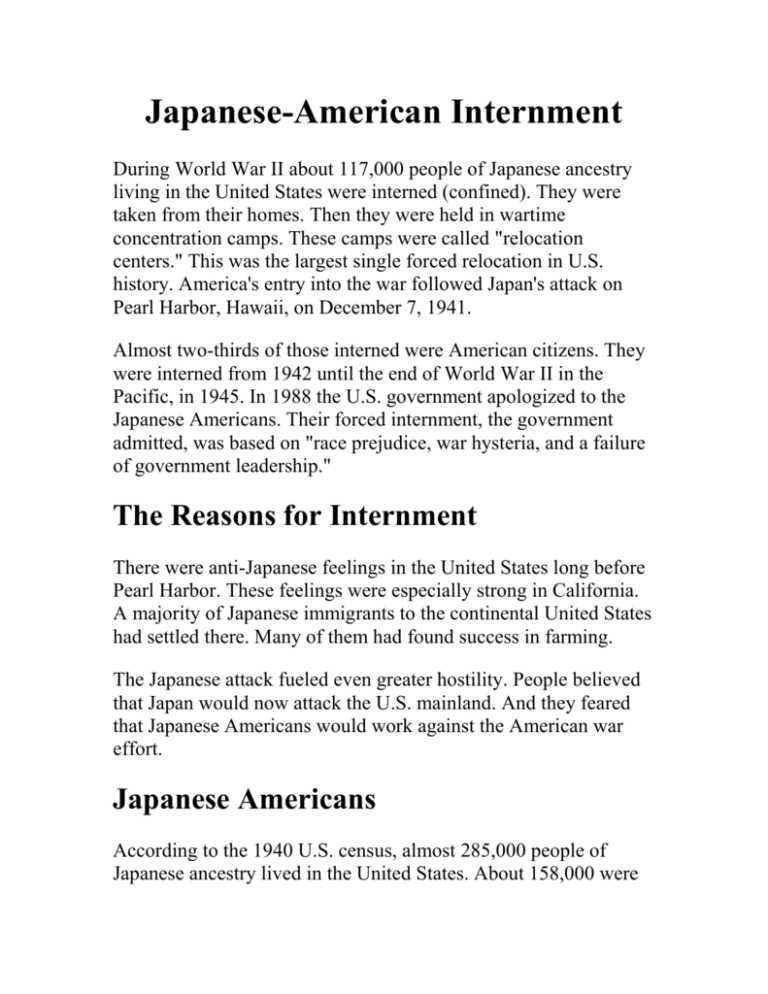
Japanese-American Internment
During World War II about 117,000 people of Japanese ancestry
living in the United States were interned (confined). They were
taken from their homes. Then they were held in wartime
concentration camps. These camps were called "relocation
centers." This was the largest single forced relocation in U.S.
history. America's entry into the war followed Japan's attack on
Pearl Harbor, Hawaii, on December 7, 1941.
Almost two-thirds of those interned were American citizens. They
were interned from 1942 until the end of World War II in the
Pacific, in 1945. In 1988 the U.S. government apologized to the
Japanese Americans. Their forced internment, the government
admitted, was based on "race prejudice, war hysteria, and a failure
of government leadership."
The Reasons for Internment
There were anti-Japanese feelings in the United States long before
Pearl Harbor. These feelings were especially strong in California.
A majority of Japanese immigrants to the continental United States
had settled there. Many of them had found success in farming.
The Japanese attack fueled even greater hostility. People believed
that Japan would now attack the U.S. mainland. And they feared
that Japanese Americans would work against the American war
effort.
Japanese Americans
According to the 1940 U.S. census, almost 285,000 people of
Japanese ancestry lived in the United States. About 158,000 were
in Hawaii, which was then a U.S. territory. The other 127,000 lived
in the continental United States. About 75 percent of those were in
California. Washington and Oregon accounted for another 14
percent.
There were no plans to intern Japanese Americans living in
Hawaii. Nor were there plans to intern Japanese Americans living
east of the Sierra Nevada mountains. Only those living on the West
Coast were interned. But they accounted for 89 percent of Japanese
Americans living in the continental United States. The Canadian
government adopted a similar policy in the province of British
Columbia.
The Internment Camps
President Franklin D. Roosevelt issued Executive Order 9066 in
February 1942. It established a Pacific military zone. All persons
of Japanese ancestry had to leave that zone. The government gave
two reasons for this. The first was to prevent spying. The second
was to protect people of Japanese descent from harm at the hands
of Americans.
Roosevelt signed another executive order in March. It created the
War Relocation Authority (WRA). The WRA soon built ten
relocation camps. Within weeks, people of Japanese ancestry were
ordered to assembly centers near their homes. They were then sent
to WRA relocation centers. These centers were situated many
miles inland. Often they were in remote and desolate areas. Sites
included Minidoka, Idaho; Manzanar, California; Topaz, Utah;
Jerome, Arkansas; Rohwer, Arkansas; Heart Mountain, Wyoming;
Gila River, Arizona; Poston, Arizona; and Granada, Colorado.
Troublesome people were sent to a special camp at Tule Lake,
California.
The internees lived in buildings made of wood and tar paper. There
were schools, libraries, hospitals, and post offices. People slept on
army cots and kept warm with coal-fired potbellied stoves. Many
made their own furniture from scrap wood. There were also guard
towers. The camps were guarded by military police.
The WRA camps were the largest and best known. The
Immigration and Naturalization Service and other agencies ran
other camps.
The End of Internment
The camps were closed after World War II ended in the Pacific in
September 1945. Many Japanese Americans returned to their home
states. Others found new places to live.
During World War II, more than 20,000 Japanese Americans had
served in the U.S. Army. Many, such as those of the 442nd
Regimental Combat Team, had fought bravely in Europe. Others
had been in U.S. military intelligence in the Pacific. Americans
soon realized that a terrible thing had been done to loyal American
citizens.
After the war, some Japanese Americans received compensation
for property losses. Their losses were estimated at more than $400
million. But Congress appropriated only $38 million to settle all
claims. Much later, Congress passed a special bill. It awarded each
of the surviving internees $20,000 in 1988. The bill also
apologized for the internment of the Japanese Americans.
Two of the internment camps are now National Historic Sites.
They are Manzanar in California and Minidoka in Idaho. The
Nidoto Nai Yoni Memorial on Bainbridge Island, Washington, is
part of the Minidoka National Historic Site. The Japanese
Americans who lived on Bainbridge Island were the first to be
forced to leave their homes. Nidoto Nai Yoni is Japanese for "Let it
not happen again."
Among the Japanese American internees who later rose to
prominence was Norman Mineta. He served in the cabinets of
Presidents Bill Clinton and George W. Bush. Other notable former
internees include singer-actress Pat Suzuki and actors Pat Morita,
Jack Soo, and George Takei. Today, Japanese Americans form a
thriving community of 1.2 million people.
How to cite this article:
MLA (Modern Language Association) style:
"Japanese-American Internment." The New Book of Knowledge.
Grolier Online, 2013. Web. 5 Feb. 2013.
Chicago Manual of Style:
"Japanese-American Internment." The New Book of Knowledge.
Grolier Online
http://nbk.grolier.com/ncpage?tn=/encyc/article.html&id=1000307
9&
type=0ta (accessed February 5, 2013).
APA (American Psychological Association) style:
Japanese-American Internment. (2013). The New Book of
Knowledge. Retrieved February 5, 2013, from Grolier Online
http://nbk.grolier.com/ncpage?tn=/encyc/article.html&id=1000307
9&
type=0ta
™ & © 2013 Scholastic Inc. All rights reserved.



